PBANKA_0105900 uroporphyrinogen III decarboxylase (UROD)
Disruptability [+]
| Species | Disruptability | Reference | Submitter | |
|---|---|---|---|---|
| P. berghei ANKA |
Refractory |
RMgm-1587 | Imported from RMgmDB | |
| P. berghei ANKA |
Possible |
RMgm-1586 | Imported from RMgmDB | |
| P. berghei ANKA |
Possible |
RMgm-1579 | Imported from RMgmDB | |
| P. berghei ANKA |
Possible |
PlasmoGEM (Barseq) | PlasmoGEM | |
| P. falciparum 3D7 |
Possible |
USF piggyBac screen (Insert. mut.) | USF PiggyBac Screen | |
Mutant phenotypes [+]
| Species | Stage | Phenotype | Reference | Submitter |
|---|---|---|---|---|
| P. berghei ANKA | Asexual |
No difference |
RMgm-1586 | Imported from RMgmDB |
| P. berghei ANKA | Ookinete |
No difference |
RMgm-1586 | Imported from RMgmDB |
| P. berghei ANKA | Oocyst |
Difference from wild-type |
RMgm-1586
Normal numbers of oocysts are formed. However, day 10 and 14 oocysts had a reduced size (`60%) compared to wild type oocysts. A large (~10-20-fold) reduction in the numbers of midgut-associated sporozoites was observed. No hemocoel or salivary gland sporozoites were detected. |
Imported from RMgmDB |
| P. berghei ANKA | Sporozoite |
Difference from wild-type |
RMgm-1586
Normal numbers of oocysts are formed. However, day 10 and 14 oocysts had a reduced size (`60%) compared to wild type oocysts. A large (~10-20-fold) reduction in the numbers of midgut-associated sporozoites was observed. No hemocoel or salivary gland sporozoites were detected. |
Imported from RMgmDB |
| P. berghei ANKA | Liver |
Difference from wild-type |
RMgm-1586
A large (~10-20-fold) reduction in the numbers of midgut-associated sporozoites was observed. No hemocoel or salivary gland sporozoites were detected. No mosquito transmission. |
Imported from RMgmDB |
Imaging data (from Malaria Metabolic Pathways)
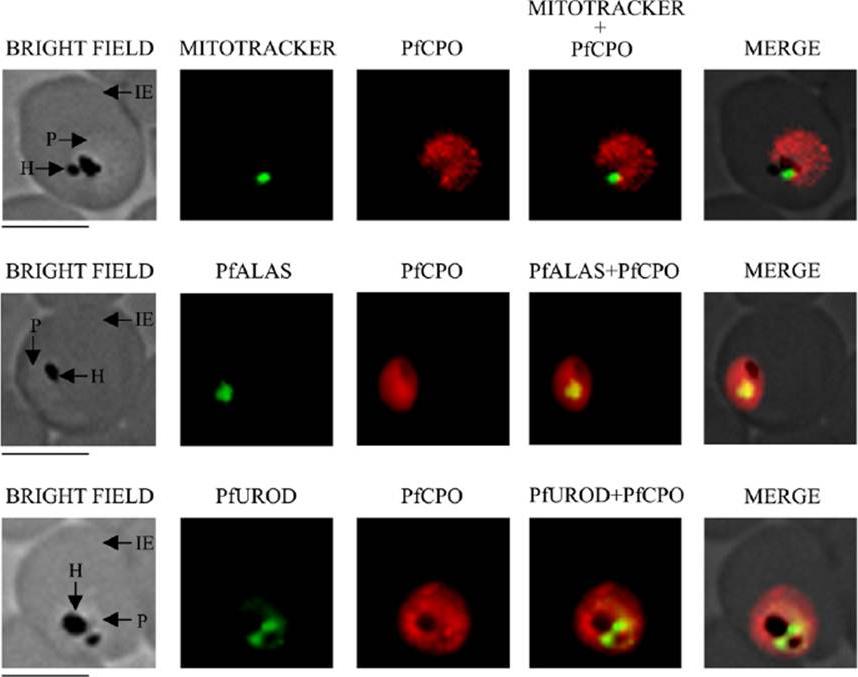
Localization of PfCPO by immunofluorescence microscopy. Localization of PfCPO with Mitotracker green (mitochondrial marker), PfALAS (mitochondrial marker) and PfUROD (apicoplast marker) was studied. IE, infected erythrocyte; P, parasite; H, hemozoin. Scale bar=5 μm. results presented in Fig. 4 indicate that the PfCPO signal was distributed throughout the parasite, but did not colocalize with that of Mitotracker dye (mitochondrial marker), PfALAS (mitochondrial marker) or PfUROD (apicoplast marker).Nagaraj VA, Prasad D, Arumugam R, Rangarajan PN, Padmanaban G. Characterization of coproporphyrinogen III oxidase in Plasmodium falciparum cytosol. Parasitol Int. 2010 59:121-127. Copyright Elsevier 2011
See original on MMP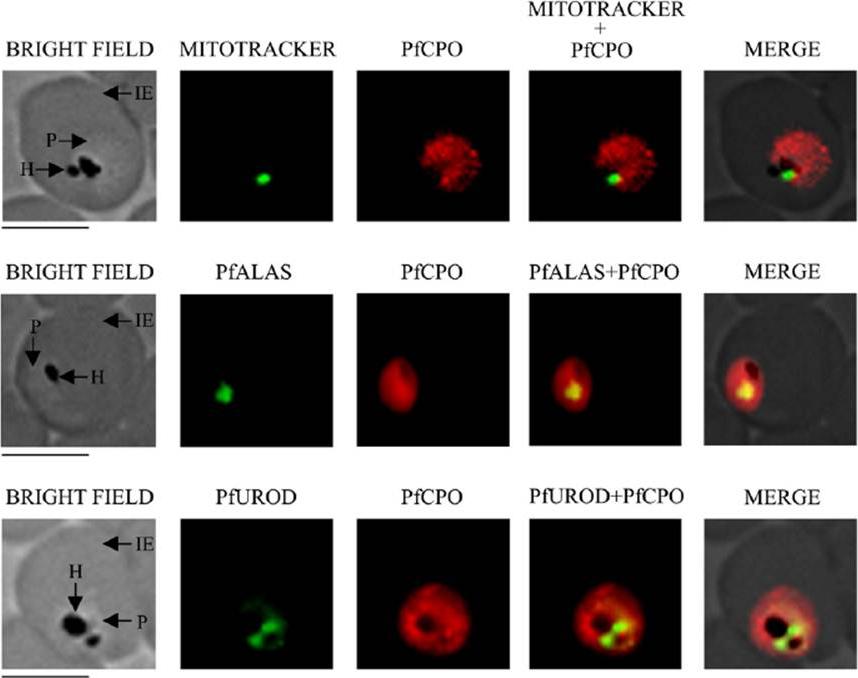
Localization of PfCPO by immunofluorescence microscopy. Localization of PfCPO with Mitotracker green (mitochondrial marker), PfALAS (mitochondrial marker) and PfUROD (apicoplast marker) was studied. IE, infected erythrocyte; P, parasite; H, hemozoin. Scale bar=5 μm. results presented in Fig. 4 indicate that the PfCPO signal was distributed throughout the parasite, but did not colocalize with that of Mitotracker dye (mitochondrial marker), PfALAS (mitochondrial marker) or PfUROD (apicoplast marker).Nagaraj VA, Prasad D, Arumugam R, Rangarajan PN, Padmanaban G. Characterization of coproporphyrinogen III oxidase in Plasmodium falciparum cytosol. Parasitol Int. 2010 59:121-127. Copyright Elsevier 2011
See original on MMP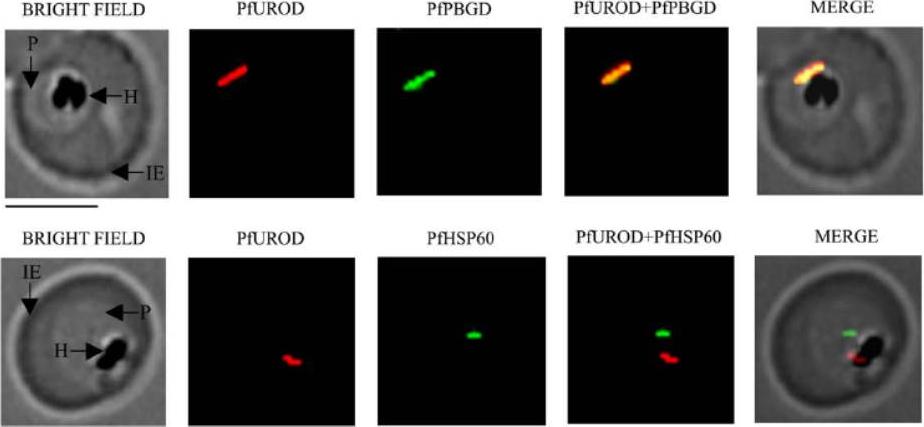
Localisation of parasite uroporphyrinogen decarboxylase (PfUROD) by immunofluorescence microscopy. Co-localisation of PfUROD with porphobilinogen deaminase (PfPBGD). Antibodies to recombinant, truncated uroporphyrinogen decarboxylase (r(D)PfUROD) were raised in mice, while PfPBGD and PfHSP60 PF10_0153 antibodies were from rabbit. To study co-localisation, tetramethylrhodamine isothiocyanate (TRITC)-conjugated goat anti-mouse IgG and FITC-conjugated goat antirabbit IgG were used. IE, infected erythrocyte; P, parasite; H, hemozoin. Scale bar = 5 mm. PfUROD co-localised with PfPBGD but not with PfHSP60 (a mitochondrial marker). Therefore, it can be concluded that PfUROD is localised in the apicoplast and not the mitochondrion.Nagaraj VA, Arumugam R, Chandra NR, Prasad D, Rangarajan PN, Padmanaban G. Localisation of Plasmodium falciparum uroporphyrinogen III decarboxylase of the heme-biosynthetic pathway in the apicoplast and characterisation of its catalytic properties. Int J Parasitol. 2009 39:559-68. Copyright Elsevier 2010.
See original on MMP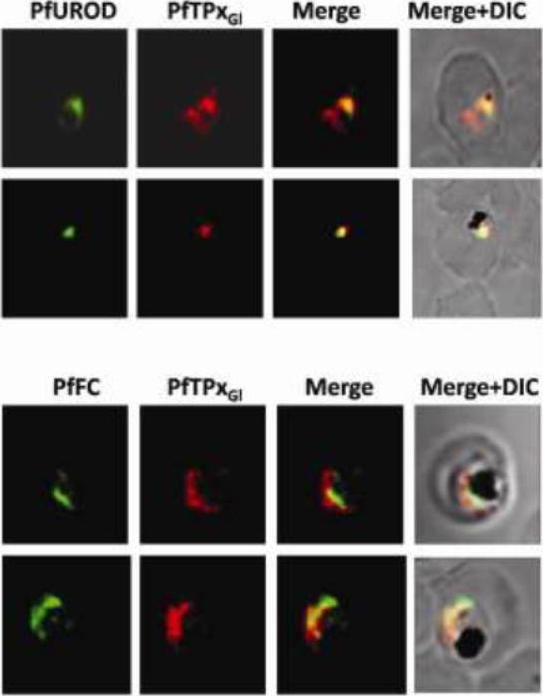
Immunofluorescence images showing multiple localizations of PfTPxGL. PfTPxGL-red signal (anti-mouse Alexa fluor 568). The imaging was carried out with scale bars varying from 5-20 mm. The infected RBCs imaged are 6-8 mm across. Parasites showing localization of PfTPxGl using antibodies purified against rPfTPxGL. In several parasites, PfTPxGL was localized exclusively to only one organelle per parasite. In some parasites, PfTPxGL co-localized with exclusively the mitochondrial markers PfUROD or PfFC. Chaudhari R, Narayan A, Patankar S. A novel trafficking pathway in Plasmodium falciparum for the organellar localization of glutathione peroxidase-like thioredoxin peroxidase. FEBS J. 2012 279(20):3872-88 PMID:
See original on MMP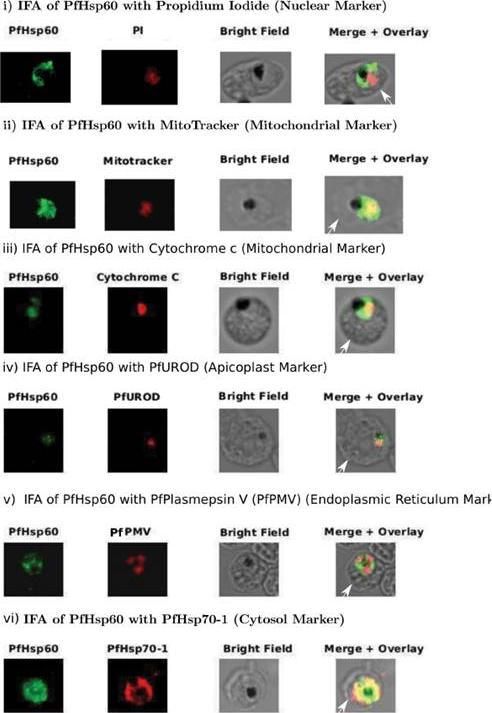
Sub-cellular distribution and localization of PfHsp60 (continued). (A) IFA of localization PfHsp60 in P. falciparum infected erythrocytes with (i) Propidium iodide (Nuclear marker), (ii) Mitotracker, (iii) PfCytochrome C (Mitochondrial marker), (iv) PfUROD (Apicoplast marker), (v) PfPlasmepsin V (PfPMV, endoplasmic reticulum marker), and (vi) PfHsp70-1 (Cytosol marker). PfHsp60 is stained with FITC-conjugated secondary antibody in all parts, while PfUROD, PfPlasmepsin V, PfCytochrome C, and PfHsp70-1 are stained with TRITC-cojugated secondary antibody in (iii), (iv), and (v). In all images, white arrow indicates the erythrocyte membrane. Part (i) shows that PfHsp60 is present only in the extra-nuclear compartment. Parts (ii) and (iii) show that PfHsp60 is present in the cytoplasm as well as in the mitochondria. The yellow signal in the merged panel shows that there is some co-localization. Part (iv) shows a lack of signal overlap with PfUROD in the merge panel. Part (v) shows a lack of signal overlap with PfPlasmepsin V in the merge panel, which rules out its localization in endoplasmic reticulum. Part (vi) shows that there is co-localization between the cytosolic protein PfHsp70-1 and PfHsp60, which indicates that PfHsp60 indeed accumulates in the cytosolPadma Priya P, Grover M, Tatu US, Natarajan V. Characterization of Precursor PfHsp60 in Plasmodium falciparum Cytosol during Its Asexual Development in Human Erythrocytes. PLoS One. 2015 Aug 28;10(8):e0136401. PMID:
See original on MMPMore information
| PlasmoDB | PBANKA_0105900 |
| GeneDB | PBANKA_0105900 |
| Malaria Metabolic Pathways | Localisation images Pathways mapped to |
| Previous ID(s) | PB001166.01.0, PBANKA_010590, UROD |
| Orthologs | PCHAS_0106500 , PF3D7_0607300 , PKNH_1143000 , PVP01_1141700 , PVX_113530 , PY17X_0107400 |
| Google Scholar | Search for all mentions of this gene |